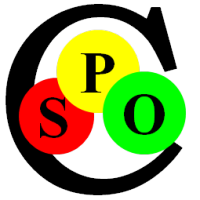This is it (almost)! The whole Semantic Web Idea is based on these three Concepts.
This Chapter provides the Terminology, including the (many) Synonyms for the individual Items, their Properties and Relationships.
Thing = Name

Synonyms: Entity, Object, Ressource, Individual, URI, URL
Anything can be a Thing in Spoc-Web if You give it a unique Name.
Things are represented by their Name in a small, rounded Box.
By entering a new Name, You create new Thing.
Entering an existing Name is one way to search for Things. Searching is quite tolerant to Typos; you get a List to choose from, ordered by decreasing Match.
Spoc-Web supports several uniqe Names for each Thing:
- the Name displayed in the Box is unique by Language.
- a unique integer Number, the so-called ID. It is shown e.g. in the Tooltip when hovering over Nodes
- unique URIs. URIs are similar to the addresses visible in the Browser like the one for this Page:
www.spoc-web.com/english/introduction/individuals/
Connection = Arrow = Relationship
Synonyms: Connection, Relationship, Edge, Arrow, Pair
Things get Meaning from the Relations they have with other Things.
These Relations can be expressed as simple Statements and consist of three Parts:
- Subject: the origin of the Arrow e.g. "Jesus"
- Relation: the Relationship Type e.g. "is Child of", often named Predicate too
- Object: the Target of the Arrow e.g. "Mary"
Any Number of Relationships can be added to a Thing.
Spoc-Web already defines about 130 Relations. You should use these when possible, to have a common Vocabulary with other Spoc-Web Users.
Of course You can create new Relations as You like and use them wherever You want.
Property = Text, Number or Time
Synonyms: Quantity, Attribute, Property
Things need Properties to describe them.
These Properties can be expressed as simple Statements and consist of three Parts:
- Subject: the Thing described e.g. "Jesus"
- Predicate: the Property Type e.g. "was born in year"
- Value: the Property Value e.g. "1"
Property Values come in three Types:
- Numbers: this can be anything: the Weight, Length, Height or geographic Location of the Thing.
- Date and Time: e.g. the Date of the Thing Creation and possibly Destruction.
-
Text: the Thing Name is mandatory, Descriptions are optional, but You can add any Number of Text Properties.
Text is localized, so that the Things can be re-used across Spoc-Web Databases worldwide.
Spoc-Web comes with a common Set of 500 Core Predicates. You should re-use these, if you want to exchange Data with other Users.
But You can create new Predicates when necessary and use these.




